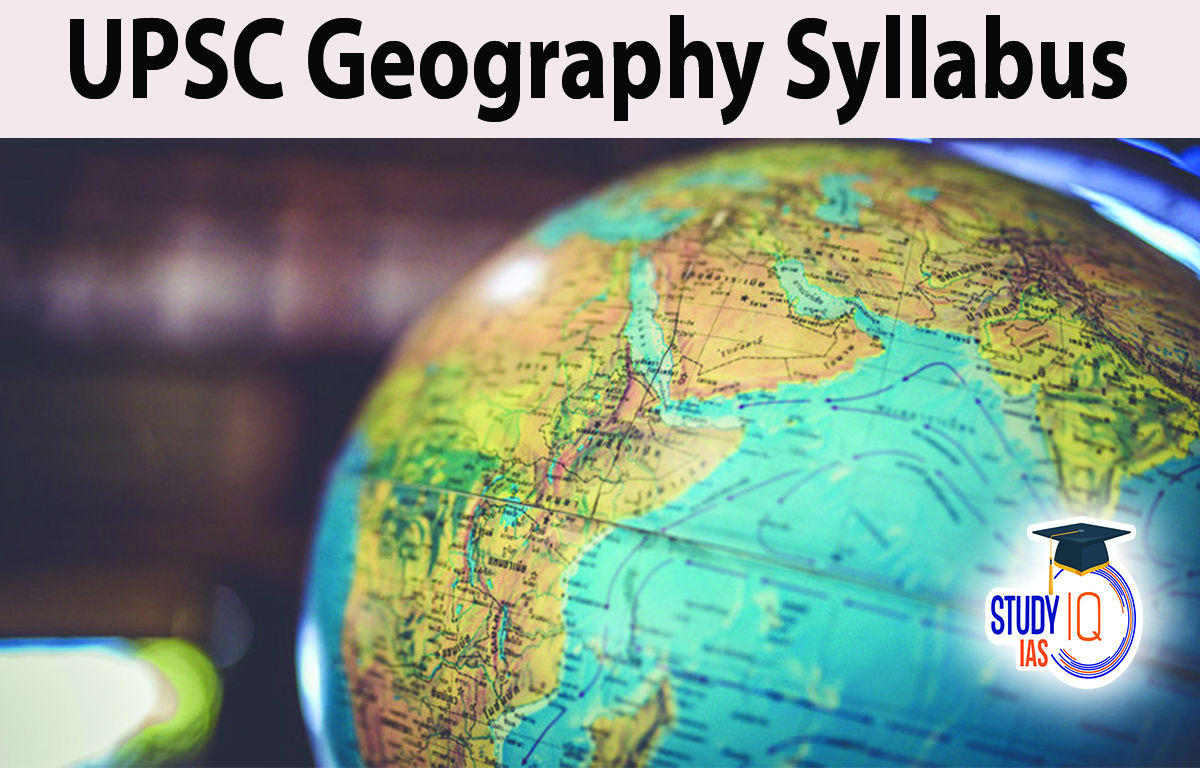Table of Contents
Geography is an important subject as far as the UPSC exam. It is a part of the UPSC prelims , mains and optional paper. There are a total of 26 optional subjects of which 25 optional are related to different disciplines and 1 is related to Literature of any 23 languages so, the total number of UPSC Optional subjects is 48. Geography is also one of them. The majority of candidates who choose geography as a graduation subject or who are interested in the subject choose it as an optional subject for the main exam. However, according to applicants who have previously passed UPSC Exams, geography is an easy-to-understand and more scientific topic, which is why many candidates with backgrounds in science, medicine, and engineering prefer it. The Geography Optional Syllabus for UPSC should be thoroughly understood by candidates in order to achieve high marks in this subject, which ultimately affects the final score in the UPSC Mains Exam.
Geography Syllabus for UPSC 2025
UPSC Geography Syllabus for Optional is designed very precisely by the UPSC to check the in-depth knowledge of the subject from the candidates. This subject is conceptual cum factual that is best for those candidates who have an interest in the physical geographical phenomenon and know about climatology, oceanography etc. The total number of marks for the UPSC Geography Optional Subject would be 500. Each paper carries 250 marks. Read the complete article for UPSC Geography Syllabus Prelims , Mains And Optional Papers 1 and 2 in detail and start preparing according to the stated topics.
UPSC Prelims Geography Syllabus 2025
UPSC Prelims syllabus 2025 for geography consist topic like Indian and World Geography – Physical, Social, Economic Geography of India and the World.
- Basics of India
- Location, latitude, longitude, time zone, etc.
- Neighbours
- Important straits
- States and their position
- States with international boundaries
- Physical features
- The Himalayas – geological formation, climate, vegetation, soil, biodiversity, physiographic divisions, major passes, significance
- The Great North Indian Plains – geological formation, physiographic divisions, climate, vegetation, soil, biodiversity, significance
- Peninsular Plateau – geological formation, Central Highlands, Deccan Plateau, Western Ghats, Eastern Ghats
- Indian Desert
- Coastal plains and islands
- River systems
- Himalayan rivers
- Peninsular rivers
- River basins
- Regional development and planning
- Hydropower projects, major dams
- West-flowing and east-flowing rivers
- Interlinking of rivers
- Climate
- Monsoons – driving mechanism, El Nino, La Nina
- Seasons
- Cyclones
- Minerals and industries – mineral distribution, industrial policies, location
- Agriculture
- Land utilisation
- Types of agricultural practices
- Green revolution
- Soils and crops
- Irrigation
- Land reforms
- Animal husbandry
- Government schemes
- Natural vegetation and fauna
- Classification of natural vegetation
- Rainfall distribution in India
- Biosphere reserves, national parks, etc.
- Red-listed species
- Economic infrastructure
- Transportation (highways, inland waterways, etc.)
- Power and energy sector
- Conventional and non-conventional sources of energy
- Energy conservation
- Human Geography
- Demographics
- Recent census
World Geography
- Major natural regions
- Regional geography of developed countries
- Regional geography of developing countries
- Regional geography of South Asia
Physical Geography
- Geomorphology
- Origin of the earth
- Interior of the earth
- Types and characteristics of rocks
- Folding and Faulting
- Volcanoes, earthquakes
- Interior of the earth
- Weathering
- Landforms formed by fluvial, aeolian and glacial actions
- Climatology
- Atmosphere – structure and composition
- Temperature
- Pressure belts of the Earth
- Wind systems
- Clouds and types of rainfall
- Cyclones and anti-cyclones
- Major climatic types
- Oceanography
- Ocean relief
- Temperature, salinity
- Ocean deposits
- Ocean currents
- El Nino and La Nina
- Waves and tides
- Biogeography
- Soil – origin and types
- Major biomes of the world
- Ecosystem, food chain
- Environmental degradation and conservation
Human Geography
- Man & environment; relationship, growth and development of human geography; determinism and possibilism
- Population, tribes, migration
- Economic activities – agriculture, manufacturing, industries, tertiary activities
- Settlements, urbanisation, functional classification of towns, million-cities and megacities
UPSC Geography Paper 1 Syllabus 2025
UPSC Geography Syllabus Paper 1 is also called Principles of Geography which is categorised into two sections one is Physical Geography and other is Human Geography. Paper 1 of the UPSC Geography Optional is all about Physical Geography and Human Geography which is majorly divided into 10 chapters, 5 chapters in each section. Every Chapter has sub-topics which are listed below in detail.
Physical Geography
- Geomorphology:
- Factors controlling landform development;
- endogenetic and exogenetic forces;
- Origin and evolution of the earth’s crusts;
- Fundamentals of geomagnetism;
- Physical conditions of the earth’s interior;
- Geosynclines;
- Continental drift;
- Isostasy;
- Plate tectonics;
- Recent views on mountain building;
- Volcanicity;
- Earthquakes and Tsunamis;
- Concepts of geomorphic cycles and Landscape development;
- Denudation chronology;
- Channel morphology;
- Erosion surfaces;
- Slope development;
- Applied Geomorphology;
- Geomorphology, economic geology, and environment.
- Climatology:
- Temperature and pressure belts of the world;
- Heat budget of the earth;
- Atmospheric circulation;
- Atmospheric stability and instability. Planetary and local winds;
- Monsoons and jet streams;
- Air masses and fronts;
- Temperate and tropical cyclones;
- Types and distribution of precipitation;
- Weather and Climate;
- Koppen’s
- Thornthwaite’s and Trewartha’s classification of world climate;
- Hydrological cycle;
- Global climatic change, and role and response of man in climatic changes Applied climatology and Urban climate.
- Oceanography:
- Bottom topography of the Atlantic, Indian, and Pacific Oceans;
- Temperature and salinity of the oceans;
- Heat and salt budgets, Ocean deposits;
- Waves, currents, and tides;
- Marine resources;
- biotic, mineral, and energy resources;
- Coral reefs coral bleaching;
- Sea-level changes;
- Law of the sea and marine pollution.
- Biogeography:
- Genesis of soils;
- Classification and distribution of soils;
- Soil profile;
- Soil erosion, Degradation, and conservation;
- Factors influencing world distribution of plants and animals;
- Problems of deforestation and conservation measures;
- Social forestry, agro-forestry;
- Wildlife;
- Major gene pool centers.
- Environmental Geography:
- Principle of ecology;
- Human ecological adaptations;
- Influence of man on ecology and environment;
- Global and regional ecological changes and imbalances;
- Ecosystem their management and conservation;
- Environmental degradation, management, and conservation;
- Biodiversity and sustainable development;
- Environmental policy;
- Environmental hazards and remedial measures;
- Environmental education and legislation.
Human Geography
- Perspectives in Human Geography:
- Areal differentiation; regional synthesis; Dichotomy and dualism; Environmentalism; Quantitative revolution and locational analysis; Radical, behavioural, human, and welfare approaches; Languages, religions, and secularisation; Cultural regions of the world; Human development index.
- Economic Geography:
- World economic development: measurement and problems; World resources and their distribution; Energy crisis; the limits to growth; World agriculture: a typology of agricultural regions; Agricultural inputs and productivity; Food and nutrition problems; Food security; famine: causes, effects, and remedies; World industries: location patterns and problems; Patterns of world trade.
- Population and Settlement Geography:
- Growth and distribution of world population; Demographic attributes; Causes and consequences of migration; Concepts of the over-under-and optimum population; Population theories, world population problems and policies, Social well-being and quality of life; Population as social capital. Types and patterns of rural settlements; Environmental issues in rural settlements; Hierarchy of urban settlements; Urban morphology; Concept of primate city and rank-size rule; Functional classification of towns; Sphere of urban influence; Rural-urban fringe; Satellite towns; Problems and remedies of urbanization; Sustainable development of cities.
- Regional Planning:
- Concept of a region; Types of regions and methods of regionalization; Growth centers and growth poles; Regional imbalances; regional development strategies; environmental issues in regional planning; Planning for sustainable development.
- Models, Theories and Laws in Human Geography:
- System analysis in Human geography; Malthusian, Marxian and demographic transition models; Central Place theories of Christaller and Losch; Perroux and Boudeville; Von Thunen’s model of agricultural location; Weber’s model of industrial location; Ostov’s model of stages of growth. Heartland and Rimland theories; Laws of international boundaries and frontiers
UPSC Geography Paper 2 Syllabus 2025
UPSC Geography Syllabus Paper 2 mainly consists Geography of India which includes Physical Setting, Cultural Setting, Settlements, Regional Development & Planning, Resources, Agriculture, Industry, Transport, Communication, Trade, Political Aspects and Contemporary Aspects.
- Physical Setting: Space relationship of India with neighbouring countries; Structure and relief; Drainage system and watersheds; Physiographic regions; Mechanism of Indian monsoons and rainfall patterns; Tropical cyclones and western disturbances; Floods and droughts; Climatic regions; Natural vegetation, Soil types and their distributions.
- Resources: Land, surface and ground water, energy, minerals, biotic and marine resources, Forest and wildlife resources and their conservation; Energy crisis.
- Agriculture: Infrastructure: irrigation, seeds, fertilizers, power; Institutional factors; land holdings, land tenure and land reforms; Cropping pattern, agricultural productivity, agricultural intensity, crop combination, land capability; Agro and social-forestry; Green revolution and its socio-economic and ecological implications; Significance of dry farming; Livestock resources and white revolution; Aquaculture; Sericulture, Agriculture and poultry; Agricultural regionalisation; Agro-climatic zones; Agroecological regions.
- Industry: Evolution of industries; Locational factors of cotton, jute, textile, iron and steel, aluminium, fertiliser, paper, chemical and pharmaceutical, automobile, cottage, and ago-based industries; Industrial houses and complexes including public sector undertakings; Industrial regionalisation; New industrial policy; Multinationals and liberalisation; Special Economic Zones; Tourism including ecotourism.
- Transport, Communication, and Trade: Road, railway, waterway, airway, and pipeline networks and their complementary roles in regional development; Growing importance of ports on national and foreign trade; Trade balance; Trade Policy; Export processing zones; Developments in communication and information technology and their impacts on economy and society; Indian space programme.
- Cultural Setting: Historical Perspective of Indian Society; Racial linguistic and ethnic diversities; religious minorities; Major tribes, tribal areas, and their problems; Cultural regions; Growth, distribution, and density of population; Demographic attributes: sex-ratio, age structure, literacy rate, work-force, dependency ratio, longevity; migration (inter-regional, intraregional and international) and associated problems; Population problems and policies; Health indicators.
- Settlements: Types, patterns, and morphology of rural settlements; Urban developments; Morphology of Indian cities; Functional classification of Indian cities; Conurbations and metropolitan regions; Urban sprawl; Slums and associated problems; Town planning; Problems of urbanisation and remedies.
- Regional Development and Planning: Experience of regional planning in India; Five Year Plans; Integrated rural development programmes; Panchayati Raj and decentralised planning; Command area development; Watershed management; Planning for the backward area, desert, drought-prone, hill tribal area development; Multi-level planning; Regional planning and development of island territories.
- Political Aspects: Geographical basis of Indian federalism; State reorganization; Emergence of new states; Regional consciousness and inter-state issues; the International boundary of India and related issues; Cross-border terrorism; India’s role in world affairs; Geopolitics of South Asia and the Indian Ocean realm.
- Contemporary Issues: Ecological issues: Environmental hazards: landslides, earthquakes, Tsunamis, floods and droughts, epidemics; Issues related to environmental pollution; Changes in patterns of land use; Principles of environmental impact assessment and environmental management; Population explosion and food security; Environmental degradation; Deforestation, desertification, and soil erosion; Problems of agrarian and industrial unrest; Regional disparities in economic development; Concept of sustainable growth and development; Environmental awareness; Linkage of rivers; Globalisation and Indian economy.


 Gestational Diabetes Mellitus (GDM), Cau...
Gestational Diabetes Mellitus (GDM), Cau...
 International Days List of 2025, Importa...
International Days List of 2025, Importa...
 Daily Quiz 14 April 2025
Daily Quiz 14 April 2025





















